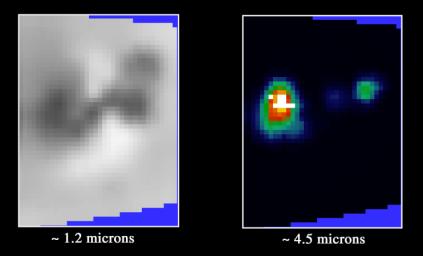
|
Galileo’s Near-Infrared Mapping Spectrometer Detects Active Lava Flows at Prometheus Volcano, Io
- Click the image above for a larger view
- Full-Res JPEG (959 x 581) (35.0 kB)
- Full-Res TIFF (959 x 581) (68.0 kB)
Caption:
The active volcano Prometheus on Jupiter's moon Io was imaged by the near-infrared mapping spectrometer instrument onboard NASA's Galileo spacecraft during the close flyby of Io on October 10, 1999. The images were taken at a distance of about 15,000 kilometers (9,400 miles).
The spectrometer can detect active volcanoes on Io by measuring their heat in the near-infrared wavelengths (just beyond the red end of human vision). It can also obtain information on the composition of materials on Io's surface using the same wavelengths.
The image on the left, taken at an infrared wavelength, shows the different compositions of materials on the volcano. The dark material is thought to be silicate lava, and the white material is sulfur dioxide frost. Sulfur dioxide erupts out of this volcano as a plume and condenses into snow by the time it reaches the ground, forming a distinctive white ring around the volcano.
The image on the right was taken at a longer infrared wavelength that shows heat coming out of the volcano. The hottest areas appear white and the coolest appear black. From this image, it is clear that there are two major "hot spots" (high-temperature areas) on this volcano. The hottest area (white spot on the left) corresponds to a location where images taken by Galileo's camera show a complex lava flow field. The cooler "hot spot" (green spot on the right) is located near where camera images show a newly-discovered volcanic caldera . The high temperatures at both hot spots are probably due to active lava flowing on the surface.
Previous observations of the Prometheus region by the spectrometer, taken when the spacecraft was at much greater distances from Io, showed Prometheus to be a persistently active volcano. Temperatures calculated from spectrometer data areas high as about 800 degrees Celsius or 1,500 Fahrenheit), similar to those of cooling lava flows in Hawaii.
Background Info:
The Jet Propulsion Laboratory, Pasadena, CA manages the Galileo mission for NASA's Office of Space Science, Washington, DC.
This image and other images and data received from Galileo are posted on the World Wide Web, on the Galileo mission home page at http://galileo.jpl.nasa.gov/ . Background information and educational context for the images can be found at http://galileo.jpl.nasa.gov/images/images.html
Cataloging Keywords:
| Name | Value | Additional Values |
|---|---|---|
| Target | Io | |
| System | Jupiter | |
| Target Type | Satellite | |
| Mission | Galileo | |
| Instrument Host | Galileo Orbiter | |
| Host Type | Orbiter | |
| Instrument | Near-Infrared Mapping Spectrometer (NIMS) | |
| Detector | ||
| Extra Keywords | Color, Infrared, Plume, Volcano | |
| Acquisition Date | ||
| Release Date | 1999-11-04 | |
| Date in Caption | 1999-10-10 | |
| Image Credit | NASA/JPL | |
| Source | photojournal.jpl.nasa.gov/catalog/PIA02509 | |
| Identifier | PIA02509 | |
